SKODA OCTAVIA 2009 2.G / (1Z) Owner's Manual
Manufacturer: SKODA, Model Year: 2009, Model line: OCTAVIA, Model: SKODA OCTAVIA 2009 2.G / (1Z)Pages: 304, PDF Size: 19.56 MB
Page 161 of 304
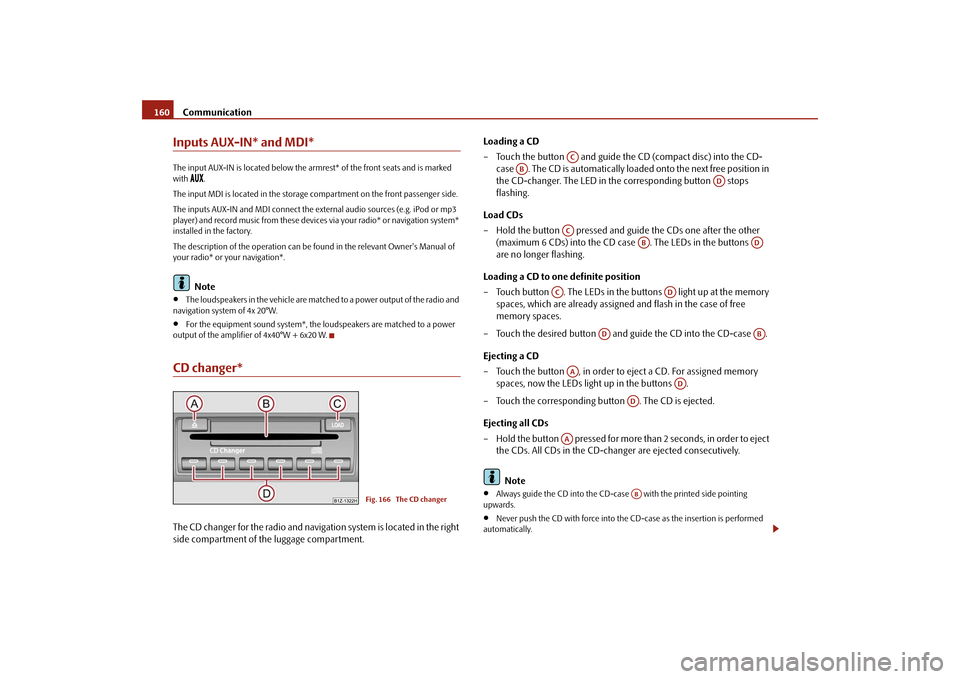
Communication
160
Inputs AUX-IN* and MDI*The input AUX-IN is located below the armr
est* of the front seats and is marked
with
.
The input MDI is located in the storage compartment on the front passenger side.The inputs AUX-IN and MDI connect the ex
ternal audio sources (e.g. iPod or mp3
player) and record music from these device
s via your radio* or navigation system*
installed in the factory. The description of the operation can be
found in the relevant Owner's Manual of
your radio* or your navigation*.
Note
•
The loudspeakers in the vehicle are matched to a power output of the radio and
navigation system of 4x 20°W.•
For the equipment sound system*, the loudspeakers are matched to a power
output of the amplifier of 4x40°W + 6x20 W.CD changer*The CD changer for the radio and navigation system is located in the right side compartment of the luggage compartment.
Loading a CD – Touch the button and guide the
CD (compact disc) into the CD-
case . The CD is automatically loaded onto the next free position in the CD-changer. The LED in the corresponding button stops flashing.
Load CDs – Hold the button pressed and guide the CDs one after the other
(maximum 6 CDs) into the CD case
. The LEDs in the buttons
are no longer flashing.
Loading a CD to one definite position – Touch button . The LEDs in the buttons light up at the memory
spaces, which are already assigned and flash in the case of free memory spaces.
– Touch the desired button and guide the CD into the CD-case . Ejecting a CD – Touch the button , in order to eject a CD. For assigned memory
spaces, now the LEDs light up in the buttons .
– Touch the corresponding button . The CD is ejected. Ejecting all CDs – Hold the button pressed for more th
an 2 seconds, in order to eject
the CDs. All CDs in the CD-changer are ejected consecutively. Note
•
Always guide the CD into the CD-cas
e with the printed side pointing
upwards.•
Never push the CD with force into the CD-case as the insertion is performed
automatically.
Fig. 166 The CD changer
AC
AB
AD
AC
AB
AD
AC
AD
AD
AB
AA
AD
AD
AA
AB
se0.1.book Page 160 Frida
y, April 10, 2009 3:19 PM
Page 162 of 304

Communication
161
Using the system
Safety
Driving Tips
General Maintenance
Breakdown assistance
Technical Data
•
After loading a CD into the CD-changer
, you must wait until the LED of the
corresponding button lights up. Then th
e CD-case is free to load the next
CD.•
If you have selected a position, on which a CD is already located, this CD will be
ejected. Take out the ejected CD and load the desired CD.
AD
AB
se0.1.book Page 161 Frida
y, April 10, 2009 3:19 PM
Page 163 of 304
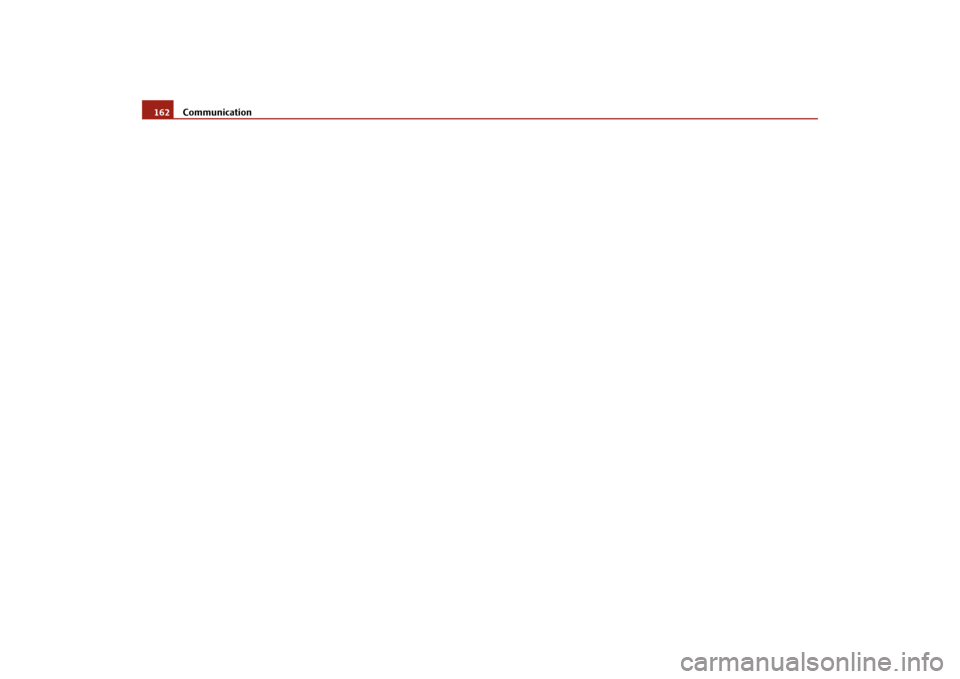
Communication
162
se0.1.book Page 162 Frida
y, April 10, 2009 3:19 PM
Page 164 of 304

Passive Safety
163
Using the system
Safety
Driving Tips
General Maintenance
Breakdown assistance
Technical Data
SafetyPassive SafetyBasic informationDriving the safe way Passive safety measures reduce the risk of injury in accident situa- tions.In this section you will find important inform
ation, tips and notes on the subject of
passive safety in your vehicle. We ha
ve combined everything here which you
should be familiar with, for
example, regarding seat belts, airbags, child seats and
safety of children. It is therefore importan
t, in particular, to comply with the notes
and warnings in this section for your own interest and in the interest of those trav- elling with you.
WARNING
•
This chapter contains important information on how to use the vehicle
for the driver and his occupants. You will find further information on safety, which concerns you and those travelling with you, in the following chapters of this Owner's Manual.•
The complete on-board literature should always be in the vehicle. This
applies in particular, if you rent out or sell the vehicle.Safety equipment The safety equipment is part of the occupant protection and it can reduce the risk of injuries in accident situations.“Do not put at risk” your safety and the safety of those travelling with you . In the event of an accident, the safety equipmen
t can reduce the risk of injuries. The
following list contains part of th
e safety equipment in your vehicle:
•
Three-point seat belts for all the seats,
•
belt force limiter for front and outer rear seats*,
•
belt tensioner
for front seats,
•
seat belt height adjuster for front seats,
•
front airbag for the driver and the front seat passenger*,
•
side airbags*,
•
head airbags*,
•
anchoring points for child seat using the “ISOFIX” system,
•
anchoring points for child seat
using the “Top Tether” system,
•
head restraint adjustable for height,
•
adjustable steering column.
The specified safety equipment works toge
ther, in order to optimally protect you
and those travelling with you in accident
situations. The safety
equipment does not
protect you or the people travelling with
you, if you or your occupants adopt an
incorrect seated position or the equipmen
t is not correctly
adjusted or used.
Fo r t h i s re a s o n y o u w i l l b e p ro v i d e d w i th i n fo rm a ti o n o n w hy t h i s e q u i p m e nt i s v e r y important, how it protects you and the o
ccupants, what should be observed when
using the equipment and how you and the pe
ople travelling with you can make full
use of the existing safety equipment.
This Owner's Manual contains important
warning notes, which you and those travelli
ng with you should pay attention to in
order to reduce a risk of injury. Safety concerns everybody!
se0.1.book Page 163 Frida
y, April 10, 2009 3:19 PM
Page 165 of 304
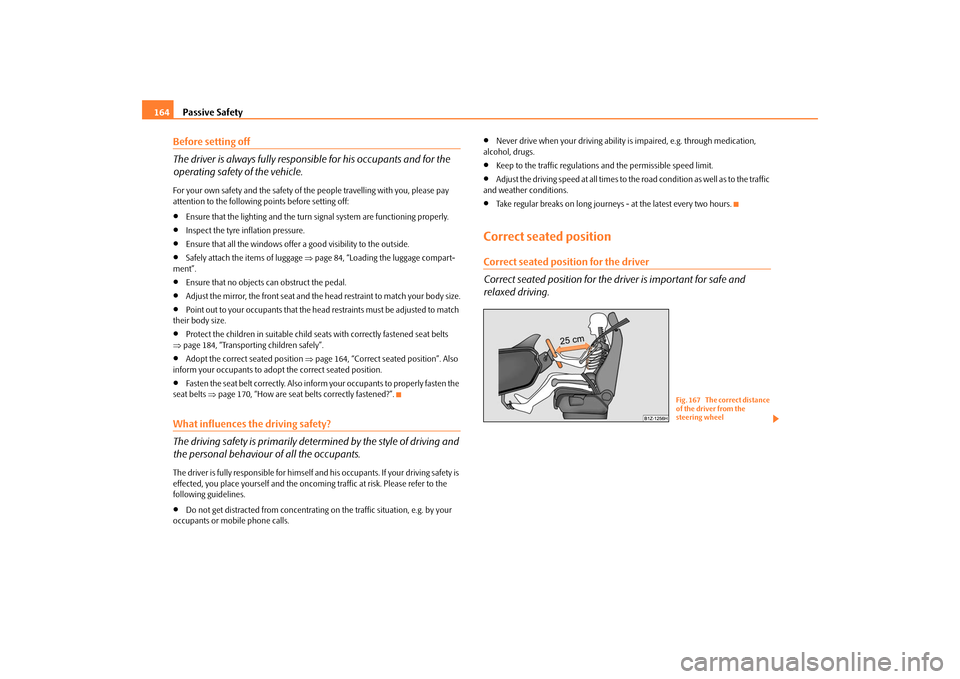
Passive Safety
164
Before setting off The driver is always fully respon
sible for his occupants and for the
operating safety of the vehicle.For your own safety and the safety of the
people travelling with you, please pay
attention to the following points before setting off:•
Ensure that the lighting and the turn signal system are functioning properly.
•
Inspect the tyre inflation pressure.
•
Ensure that all the windows offer a good visibility to the outside.
•
Safely attach the items of luggage
⇒page 84, “Loading the luggage compart-
ment”.•
Ensure that no objects can obstruct the pedal.
•
Adjust the mirror, the front seat and the head restraint to match your body size.
•
Point out to your occupants that the head restraints must be adjusted to match
their body size.•
Protect the children in suitable child se
ats with correctly fastened seat belts
⇒ page 184, “Transporting children safely”.•
Adopt the correct seated position
⇒page 164, “Correct seated position”. Also
inform your occupants to adop
t the correct seated position.
•
Fasten the seat belt correctly. Also inform your occupants to properly fasten the
seat belts
⇒page 170, “How are seat belts correctly fastened?”.
What influences the driving safety? The driving safety is primarily dete
rmined by the style of driving and
the personal behaviour of all the occupants.The driver is fully responsible for himself and his occupants. If your driving safety is effected, you place yourself and the oncomi
ng traffic at risk. Please refer to the
following guidelines.•
Do not get distracted from concentrating on the traffic situation, e.g. by your
occupants or mobile phone calls.
•
Never drive when your driving ability is impaired, e.g. through medication,
alcohol, drugs.•
Keep to the traffic regulations and the permissible speed limit.
•
Adjust the driving speed at all times to the road condition as well as to the traffic
and weather conditions.•
Take regular breaks on long journeys - at the latest every two hours.
Correct seated positionCorrect seated position for the driver Correct seated position for the dr
iver is important for safe and
relaxed driving.
Fig. 167 The correct distance of the driver from the steering wheel
se0.1.book Page 164 Frida
y, April 10, 2009 3:19 PM
Page 166 of 304

Passive Safety
165
Using the system
Safety
Driving Tips
General Maintenance
Breakdown assistance
Technical Data
For your own safety and to reduce the risk of injury in the event of an accident, we recommend the following setting:•
Adjust the steering wheel so that the distance between the steering wheel and
your chest is at least 25 cm
⇒page 164, fig. 167
.
•
Position the driver seat in the forward/back direction so that you are able to
press the pedals with your
legs at a slight angle .
•
Adjust the backrest so that you are able
to reach the highest point of the steering
wheel with your arms at a slight angle.•
Adjust the head restraint so that the top edge of the head restraint is at the same
level as the upper part of your head
⇒fig. 168
.
•
Fasten the seat belt correctly
⇒page 170, “How are seat belts correctly
fastened?”. Manual driver seat adjustment
⇒page 12, “Adjusting the front seats”.
Electrical driver seat adjustment
⇒page 76, “Adjusting front seats electrically*”.
WARNING
•
The front seats and the head restraints must always be adjusted to match
the body size of the seat occupant as well as the seat belts must always be correctly fastened in order to provide an optimal protection for you and your occupants.
•
The driver must maintain a distance of at least 25 cm to the steering
wheel
⇒page 164, fig. 167
. Not maintaining this minimum distance will
mean that the airbag system will not be able to properly protect you - hazard!•
When driving, hold the steering wheel
with both hands firmly on the
outer edge in the 9 o'clock and 3 o'clock position. Never hold the steering wheel firmly in the 12 o'clock position or in another way (e.g. in the middle of the steering wheel or
at the inner steering wheel edge). In such cases,
injuries to the arms, the hands and
the head can occur when the driver
airbag is deployed.•
The backrests must not be angled to
o far back when driving otherwise
this will affect proper operation of the seat belts and of the airbag system - risk of injury!•
Ensure that there are no objects in the footwell as any objects may get
behind the pedals during a driving or
braking manoeuvre. You would then
no longer be able to operate the clutch, to brake or accelerate.Correct seated position for the front passenger The front passenger must maintain a distance of at least 25 cm from the dash panel so that the airbag offers the greatest possible safety when an airbag is deployed.For the safety of the front passenger and to
reduce the risk of injury in the event of
an accident, we recommend the following setting:•
Adjust the front passenger seat as far as possible to the rear.
•
Adjust the head restraint so that the top edge of the head restraint is at the same
level as the upper part of your head
⇒fig. 168
.
•
Fasten the seat belt correctly
⇒page 170, “How are seat belts correctly
fastened?”. In exceptional cases the front pass
enger airbag can be deactivated
⇒page 181,
“Deactivating an airbag”.
Fig. 168 The correct head restraint adjustment for the driver
WARNING (continued)
se0.1.book Page 165 Frida
y, April 10, 2009 3:19 PM
Page 167 of 304
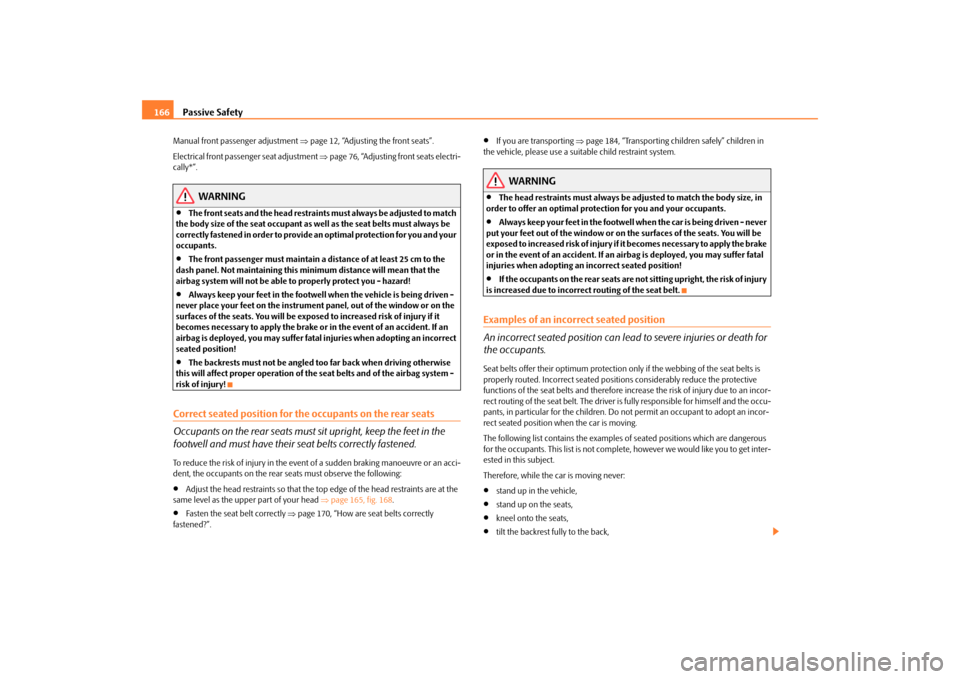
Passive Safety
166
Manual front passenger adjustment
⇒page 12, “Adjusting the front seats”.
Electrical front passenger seat adjustment
⇒page 76, “Adjusting front seats electri-
cally*”.
WARNING
•
The front seats and the head restraints must always be adjusted to match
the body size of the seat occupant as well as the seat belts must always be correctly fastened in order to provide an optimal protection for you and your occupants.•
The front passenger must maintain a distance of at least 25 cm to the
dash panel. Not maintaining this minimum distance will mean that the airbag system will not be able
to properly protect you - hazard!
•
Always keep your feet in the footwel
l when the vehicle is being driven -
never place your feet on the instrument panel, out of the window or on the surfaces of the seats. You will be exposed to increased risk of injury if it becomes necessary to apply the brake or in the event of an accident. If an airbag is deployed, you may suffer fata
l injuries when adopting an incorrect
seated position!•
The backrests must not be angled too far back when driving otherwise
this will affect proper operation of th
e seat belts and of the airbag system -
risk of injury!Correct seated position for the occupants on the rear seats Occupants on the rear seats must sit upright, keep the feet in the footwell and must have their se
at belts correctly fastened.
To reduce the risk of injury in the event of a sudden braking manoeuvre or an acci- dent, the occupants on the rear seats must observe the following:•
Adjust the head restraints so that the top edge of the head restraints are at the
same level as the upper part of your head
⇒page 165, fig. 168
.
•
Fasten the seat belt correctly
⇒page 170, “How are seat belts correctly
fastened?”.
•
If you are transporting
⇒page 184, “Transporting children safely” children in
the vehicle, please use a suitable child restraint system.
WARNING
•
The head restraints must always be adjusted to match the body size, in
order to offer an optimal protection for you and your occupants.•
Always keep your feet in the footwell
when the car is being driven - never
put your feet out of the window or on the surfaces of the seats. You will be exposed to increased risk of injury if it becomes necessary to apply the brake or in the event of an accident. If an airbag is deployed, you may suffer fatal injuries when adopting an incorrect seated position!•
If the occupants on the rear seats are not sitting upright, the risk of injury
is increased due to incorrec
t routing of the seat belt.
Examples of an incorrect seated position An incorrect seated position can lead to severe injuries or death for the occupants.Seat belts offer their optimum protection on
ly if the webbing of the seat belts is
properly routed. Incorrect seated positio
ns considerably reduce the protective
functions of the seat belts and therefore incr
ease the risk of injury due to an incor-
rect routing of the seat belt. The driver is fully responsible for himself and the occu-pants, in particular for the children. Do
not permit an occupant to adopt an incor-
rect seated position when the car is moving. The following list contains
the examples of seated positions which are dangerous
for the occupants. This list is not comple
te, however we would like you to get inter-
ested in this subject. Therefore, while the car is moving never:•
stand up in the vehicle,
•
stand up on the seats,
•
kneel onto the seats,
•
tilt the backrest fully to the back,
se0.1.book Page 166 Frida
y, April 10, 2009 3:19 PM
Page 168 of 304

Passive Safety
167
Using the system
Safety
Driving Tips
General Maintenance
Breakdown assistance
Technical Data
•
lean against the dash panel,
•
lie on the rear seats,
•
only sit on the front area of the seat,
•
sit to the side,
•
lean out of the window,
•
put the feet out of the window,
•
put the feet on the dash panel,
•
put the feet on the seat upholstery,
•
occupy the footwell,
•
have the seat belt not fastened,
•
occupy the luggage compartment.
WARNING
•
If the occupant adopts an incorrect seated position, he is exposed to life-
threatening injuries, in case he
is hit by a deployed airbag.
•
Before setting off, please adopt the correct seated position and do not
change this seated position while the car is moving. Also advise your occu- pants to adopt the correct seated position and not to change this seated position while the car is moving.
se0.1.book Page 167 Frida
y, April 10, 2009 3:19 PM
Page 169 of 304
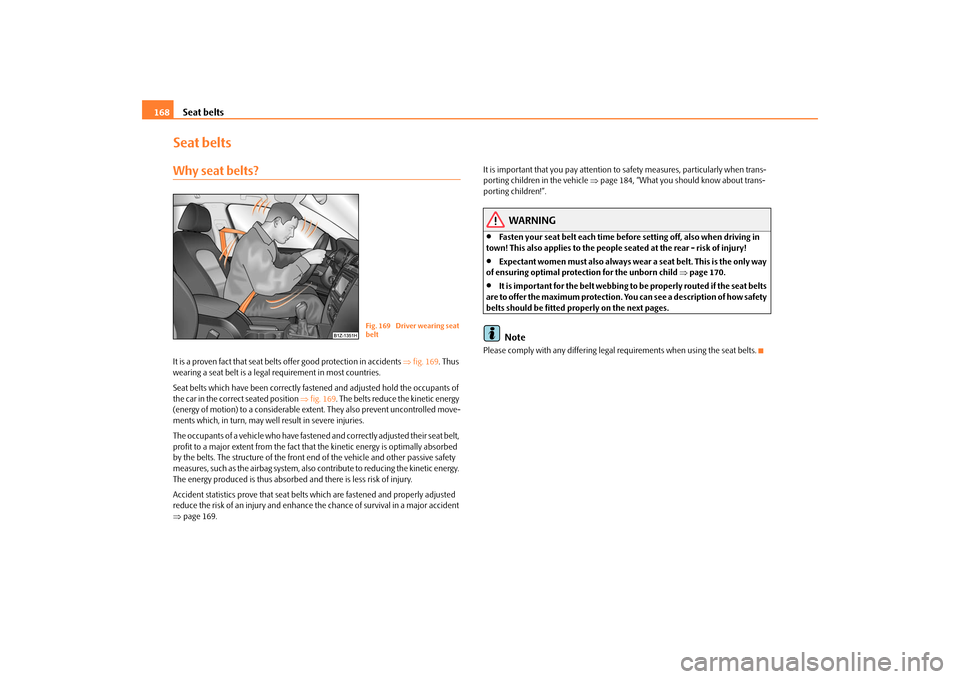
Seat belts
168
Seat beltsWhy seat belts?It is a proven fact that seat belt
s offer good protection in accidents
⇒fig. 169
. Thus
wearing a seat belt is a legal requirement in most countries. Seat belts which have been correctly fastened and adjusted hold the occupants of the car in the correc
t seated position
⇒fig. 169
. The belts reduce the kinetic energy
(energy of motion) to a considerable extent. They also prevent uncontrolled move-ments which, in turn, may well result in severe injuries. The occupants of a vehicle who have fastened
and correctly adjusted their seat belt,
profit to a major extent from the fact that
the kinetic energy is optimally absorbed
by the belts. The structure of the front end of the vehicle and other passive safety measures, such as the airbag system, also
contribute to reducing the kinetic energy.
The energy produced is thus absorbed and there is less risk of injury. Accident statistics prove that seat belts
which are fastened and properly adjusted
reduce the risk of an injury and enhance the chance of survival in a major accident ⇒ page 169.
It is important that you pay attention to
safety measures, particularly when trans-
porting children in the vehicle
⇒page 184, “What you should know about trans-
porting children!”.
WARNING
•
Fasten your seat belt each time before setting off, also when driving in
town! This also applies to the people seated at the rear - risk of injury!•
Expectant women must also always wear
a seat belt. This is the only way
of ensuring optimal protection for the unborn child
⇒page 170.
•
It is important for the belt webbing to
be properly routed if the seat belts
are to offer the maximum protection. You can see a description of how safety belts should be fitted pr
operly on the next pages.
Note
Please comply with any differing legal
requirements when using the seat belts.
Fig. 169 Driver wearing seat belt
se0.1.book Page 168 Frida
y, April 10, 2009 3:19 PM
Page 170 of 304

Seat belts
169
Using the system
Safety
Driving Tips
General Maintenance
Breakdown assistance
Technical Data
The physical principle of a frontal collisionThe physical principle of a frontal a
ccident can be explained quite simply:
Motion energy, so-called kinetic energy, is
produced as soon as the vehicle is
moving, both for the vehicle and its occupants. The magnitude of this kinetic energy depends essentially on the speed at which the vehicle is travelling and on the weight of the vehicle and the occupants. The greater the speed and weight increase,
the greater the amount of energy which has to be absorbed in the event of an acci- dent. The speed of the vehicle is, nevertheless,
the most important factor. Doubling the
speed of the vehicle from 25 km/h up to
50 km/hour increases the kinetic energy
four times. The common opinion that it is possible to
support your body
in a minor accident
with your hands, is incorrect. Even in a
collision at only a low speed, the forces
acting on the body are such that it is
no longer possible to support your body.
Even if you only drive at a speed within the range from 30 km/hour to 50 km/hour, the forces which are produced on your body
in the event of an accident can easily
exceed 10.000 N (Newton). This equals a weight of one tonne (1 000 kg). In the event of a frontal collision, occupants of the car not wearing a seat belt, are thrown forward and strike in an uncontrolled way parts of the interior of the car, such as steering wheel, dash panel, windscreen,
⇒fig. 170
. The occupants of a
vehicle who have not fastened their seat belts may even be thrown out of the vehicle. This can resu
lt in fatal injuries.
It is also important that rear seat occupants fasten their seat belts as they will other- wise be thrown through the vehicle in an
uncontrolled manner in the event of an
accident A rear seat passenger who has not
fastened the seat belt is a danger not
only to himself but also fo
r those seated at the front
⇒fig. 171
.
Important safety information regarding the use of seat beltsThe correct use of the seat belts considerably reduces the risk of injury!
WARNING
•
The belt webbing must not be jammed in-between at any point or
twisted, or chafe ag
ainst any sharp edges.
•
It is important that the belt webbing is properly routed if the seat belts
are to offer their maximum protection
⇒page 170.
Fig. 170 The driver is thrown forward if not wearing a beltFig. 171 The rear seat occu-pant is thrown forward if not wearing a belt
se0.1.book Page 169 Frida
y, April 10, 2009 3:19 PM